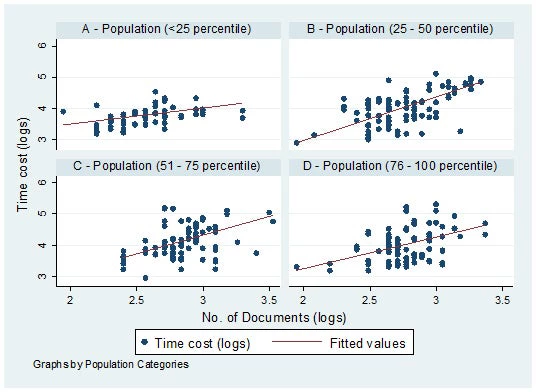At the outset, the relationship is rather straightforward: The more the number of documents needed to export or import, the longer the time it will take to clear the required procedures to trade. The policy recommendation that then follows is to reduce the time cost of trade by reducing the number of documents needed and thereby achieve trade facilitation. Correct? To an extent yes. However, further research shows that it is not always as straightforward as it seems.
In a recent paper (forthcoming International Trade Journal), we set out to explore the relationship between trade documents and the time cost of trade using data from the Doing Business project for 125 countries. The input measure is simply the number of documents required to export and import and the outcome measure is the number of days it takes to clear all procedures for exporting and importing a good. While we found an expected positive relationship between the two, the more interesting results surfaced when we explored how this relationship varies across different dimensions.
We examined whether the relationship between the number of trade documents and the time cost of trading varied by the size (total population) and income (GDP per capita) of the country. What we found was interesting. As the number of trade documents rose, the larger the country, the greater the increase in the length of time it took to clear procedures to import or export (time cost). The finding is plausible - smaller countries rely more on trade than larger countries and hence have a greater incentive to invest in efficient documentation system. We present this finding in figure 1 where we show the relationship between number of documents and length of time to trade for countries in different percentiles of population size.
Figure 1:

Similarly we found that lower income countries face longer time to trade than higher income countries when the number of documents increases by one unit. This can again be attributed to the fact that the richer countries have more resources to devote to efficient documentation systems compared to the poorer countries.
What are the implications of these findings? Depending on the country context, the impact of an input metric on an output metric may vary quite considerably. Thus, there is a risk in solely looking at an input metric to evaluate a policy success as it may not necessarily lead to the desired degree of change in the output metric. As our findings indicate, if the trade facilitation policy is being enacted for a small country, a significant reduction in the number of trade documents will not lead to a large decrease in the time to export or import. The impact would be rather small. However, it is a different case when looking at just the output metric. If the policy is found to considerably reduce the time taken to trade, then there is no doubt of the policy’s success, regardless of the number of documents reduced.
Our findings suggest that policy makers should be careful when choosing metrics to evaluate policies, and should take note of the overall goal and consider outcome metrics directly related to that goal. Concentrating only on input metrics may be too narrow a focus and not guarantee the desired degree of change - we need to go beyond and see how policy changes to input measures affect the outcome measures. We hope our study and this blog post encourages further debate on the choice of metrics for policy evaluation.
In a recent paper (forthcoming International Trade Journal), we set out to explore the relationship between trade documents and the time cost of trade using data from the Doing Business project for 125 countries. The input measure is simply the number of documents required to export and import and the outcome measure is the number of days it takes to clear all procedures for exporting and importing a good. While we found an expected positive relationship between the two, the more interesting results surfaced when we explored how this relationship varies across different dimensions.
We examined whether the relationship between the number of trade documents and the time cost of trading varied by the size (total population) and income (GDP per capita) of the country. What we found was interesting. As the number of trade documents rose, the larger the country, the greater the increase in the length of time it took to clear procedures to import or export (time cost). The finding is plausible - smaller countries rely more on trade than larger countries and hence have a greater incentive to invest in efficient documentation system. We present this finding in figure 1 where we show the relationship between number of documents and length of time to trade for countries in different percentiles of population size.
Figure 1:

Similarly we found that lower income countries face longer time to trade than higher income countries when the number of documents increases by one unit. This can again be attributed to the fact that the richer countries have more resources to devote to efficient documentation systems compared to the poorer countries.
What are the implications of these findings? Depending on the country context, the impact of an input metric on an output metric may vary quite considerably. Thus, there is a risk in solely looking at an input metric to evaluate a policy success as it may not necessarily lead to the desired degree of change in the output metric. As our findings indicate, if the trade facilitation policy is being enacted for a small country, a significant reduction in the number of trade documents will not lead to a large decrease in the time to export or import. The impact would be rather small. However, it is a different case when looking at just the output metric. If the policy is found to considerably reduce the time taken to trade, then there is no doubt of the policy’s success, regardless of the number of documents reduced.
Our findings suggest that policy makers should be careful when choosing metrics to evaluate policies, and should take note of the overall goal and consider outcome metrics directly related to that goal. Concentrating only on input metrics may be too narrow a focus and not guarantee the desired degree of change - we need to go beyond and see how policy changes to input measures affect the outcome measures. We hope our study and this blog post encourages further debate on the choice of metrics for policy evaluation.



Join the Conversation